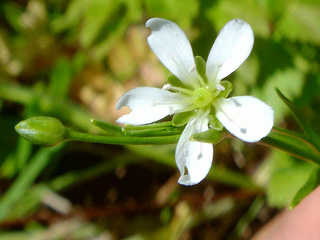 Arenaria paludicola, CDFW Photo by Krystal Acierto
Arenaria paludicola, CDFW Photo by Krystal Acierto
California native plants are not only beautiful, they are also essential components of our ecosystems and natural processes, and provide us with valuable renewable materials and other benefits. California hosts approximately 6,500 species, subspecies, and varieties of native plants, many of which are found nowhere else in the world, and many animal species depend on these native plants for food and shelter. Unfortunately, California’s unique plant biodiversity and the ecosystems upon which it depends are especially vulnerable to the effects of climate change. It is estimated that approximately 66 percent of California’s endemic plant species will experience decreases of up to 80 percent in the size of their ranges within the next 100 years.1
California Geologic and Climatic Diversity
From the Sierra Nevada Mountain range, to the coastal west; from the farmlands of the valleys to the arid Mojave Desert; California is home to a vast flora, much of which is endemic to the area. Across California’s varied geography, native plant species are highly threatened by the potential impacts of climate change such as changes in seasonal patterns of snow accumulation and snowmelt in the mountains; rising sea levels and altered wave intensity along the coast; increased temperatures and decreased water availability in the valleys; and changes in seasonal and annual mean temperature in the deserts. It is impossible to predict exactly how climate change will impact California’s native plants, yet scientists predict that it will.
Native Plant Vulnerability
Many rare, threatened, and endangered native plants are more susceptible to extinction caused by climate change due principally to small population sizes and limited suitable habitat types. While some animals have the ability to move when conditions become unfavorable, plants are immobile and thus can not as easily adapt to a quickly changing environment. Climate change may alter plant life stages such as leaf emergence or flowering period which may hinder survival and reproduction. Some studies estimate that endemic plant species’ ranges may shift up to 90 miles under intense climate change, but this shift may be a slow process relative to a rapidly changing climate1. Furthermore, plants that are restricted to extremely specific habitats are especially at risk because while the climatic environment may shift, the soil and nutrient environment will not. Invasive plant species also pose a threat to native plants because invasives tend to do well in the changing conditions that climate change is thought to promote, and those invasives may then out-compete rare plants for vital resources. It is crucial that conservation efforts aim to conserve and manage large areas of protected habitat for plants, which may rely on dispersal and a variety of habitat gradients and varied microsites to cope with the changing environment.
Management and Recommendations
The CDFW Native Plant Program works to decrease impacts on California’s diverse flora by providing information and tools necessary to conserve native plants. The program also issues permits to those working with threatened and endangered plants in order to monitor populations, collaborate on scientific and conservation projects, and make informed management decisions and plans.
What You Can Do
You can help promote the survival of native plant species by learning more about which plants are rare, threatened, or endangered in your area and by getting involved with restoration efforts (contact your regional CDFW office regarding volunteer opportunities). You can also do your part to help decrease the rate of climate change, and thus its impacts, by changing simple things you do in your everyday life(opens in new tab). You may consider joining CDFW’s Climate Stakeholder group and learn more about state adaptation planning efforts and projects to safeguard wildlife and habitats in a changing climate. The earth is a continually changing environment, but climate change has accelerated these changes. Careful conservation and sustainable practices must be adopted if we are to prevent the extinction of California native plant species.
References
1 Loarie SR, B.E. Carter, K. Hayhoe, S. McMahon, R. Moe, C.A .Knight, and D.D. Ackerly. 2008. Climate Change and the Future of California’s Endemic Flora. PLoS ONE. 3(6): 1-24.